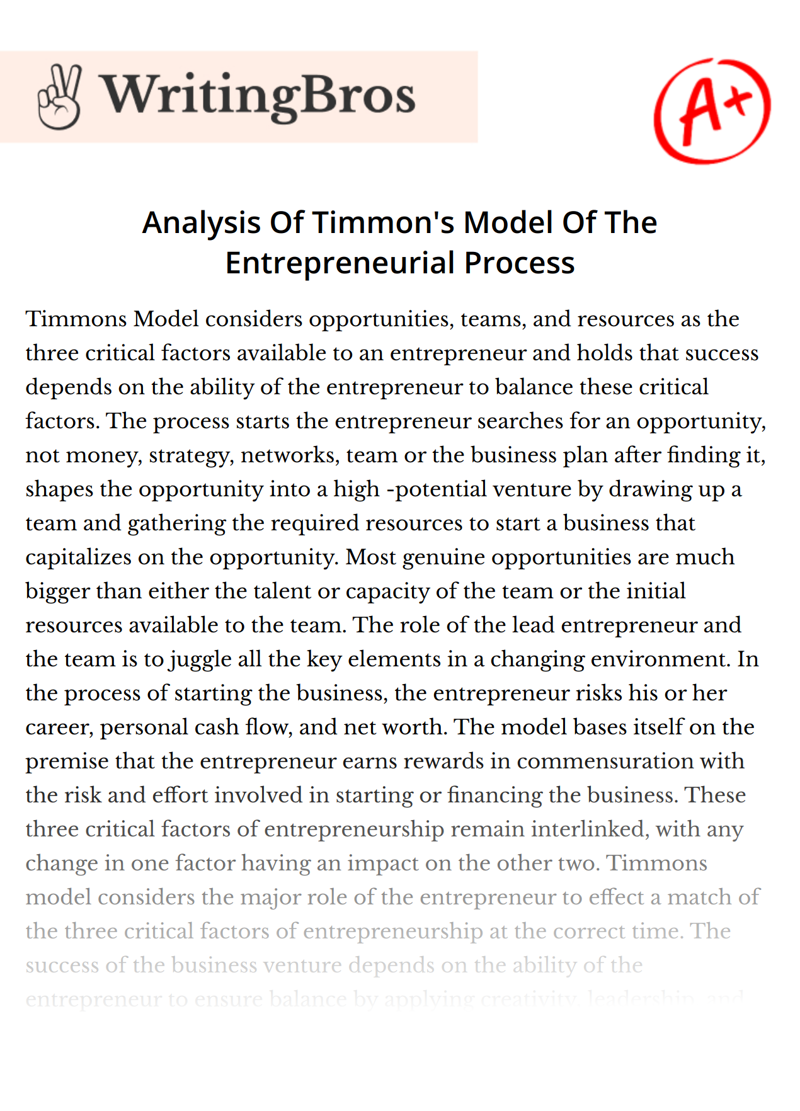Analysis Of Timmon's Model Of The Entrepreneurial Process

Table of contents
- Opportunity Factor
- Resources Factor
- Team Factor
Timmons Model considers opportunities, teams, and resources as the three critical factors available to an entrepreneur and holds that success depends on the ability of the entrepreneur to balance these critical factors. The process starts the entrepreneur searches for an opportunity, not money, strategy, networks, team or the business plan after finding it, shapes the opportunity into a high -potential venture by drawing up a team and gathering the required resources to start a business that capitalizes on the opportunity. Most genuine opportunities are much bigger than either the talent or capacity of the team or the initial resources available to the team. The role of the lead entrepreneur and the team is to juggle all the key elements in a changing environment. In the process of starting the business, the entrepreneur risks his or her career, personal cash flow, and net worth. The model bases itself on the premise that the entrepreneur earns rewards in commensuration with the risk and effort involved in starting or financing the business. These three critical factors of entrepreneurship remain interlinked, with any change in one factor having an impact on the other two. Timmons model considers the major role of the entrepreneur to effect a match of the three critical factors of entrepreneurship at the correct time. The success of the business venture depends on the ability of the entrepreneur to ensure balance by applying creativity, leadership, and maintaining effective communications.
Opportunity Factor
The Timmons model of entrepreneurship believes that entrepreneurship is opportunity driven, or the model starts with a market opportunity. Since opportunity considers as the heart of the entrepreneurial process. A good idea is not necessarily a good business opportunity, an idea becomes viable only when it remains anchored in products or services that create or add value to customers, and remains attractive, durable, and timely. The business plan and the financing receive secondary importance and come only after identification of a viable opportunity.
Resources Factor
The Timmons model discounts the accepted belief that extensive resources reduce the risk of starting a venture and encourages bootstrapping or starting a business from scratch. Bootstrapping is a way of life entrepreneurial companies and can create a significant competitive advantage.
The advantages of bootstrapping include driving down market cost, instilling discipline and leanness in the organization, encouraging creative resources to achieve more with the limited amount of money and other resources available. The practical applications of such bootstrapping methods include leasing instead of buying equipment, working out of a garage instead of rented space, etc.
Team Factor
Once the entrepreneur identifies an opportunity, he or she works to start a business by putting together the team and gathering the required resources. The size and nature of the opportunity determine the size and shape of the team. The Timmons model places special importance on the team and considers a good team as indispensable for success. The team is a key ingredient in the higher potential venture. Among all resources, only a good team can unlock a higher potential with an opportunity and manage the pressures related to growth. A bad team can waste a great idea. The two major roles of the team are removing the ambiguity and uncertainty of the opportunity by applying creativity and providing leadership to manage the available resources in the most effective manner.
These three elements are related to each other since the opportunity considers as a heart of entrepreneurial process then the entrepreneur has a brilliant idea but a good idea is not necessarily a good business opportunity and the underlying market demand determines the potential of the idea. The role of the entrepreneur in managing the resources includes building a good resource base to draw from when required and drawing up a business plan through a "fit and balance” method that balances the available resource with the opportunity and the potential of the team.
Cite this Essay
To export a reference to this article please select a referencing style below

